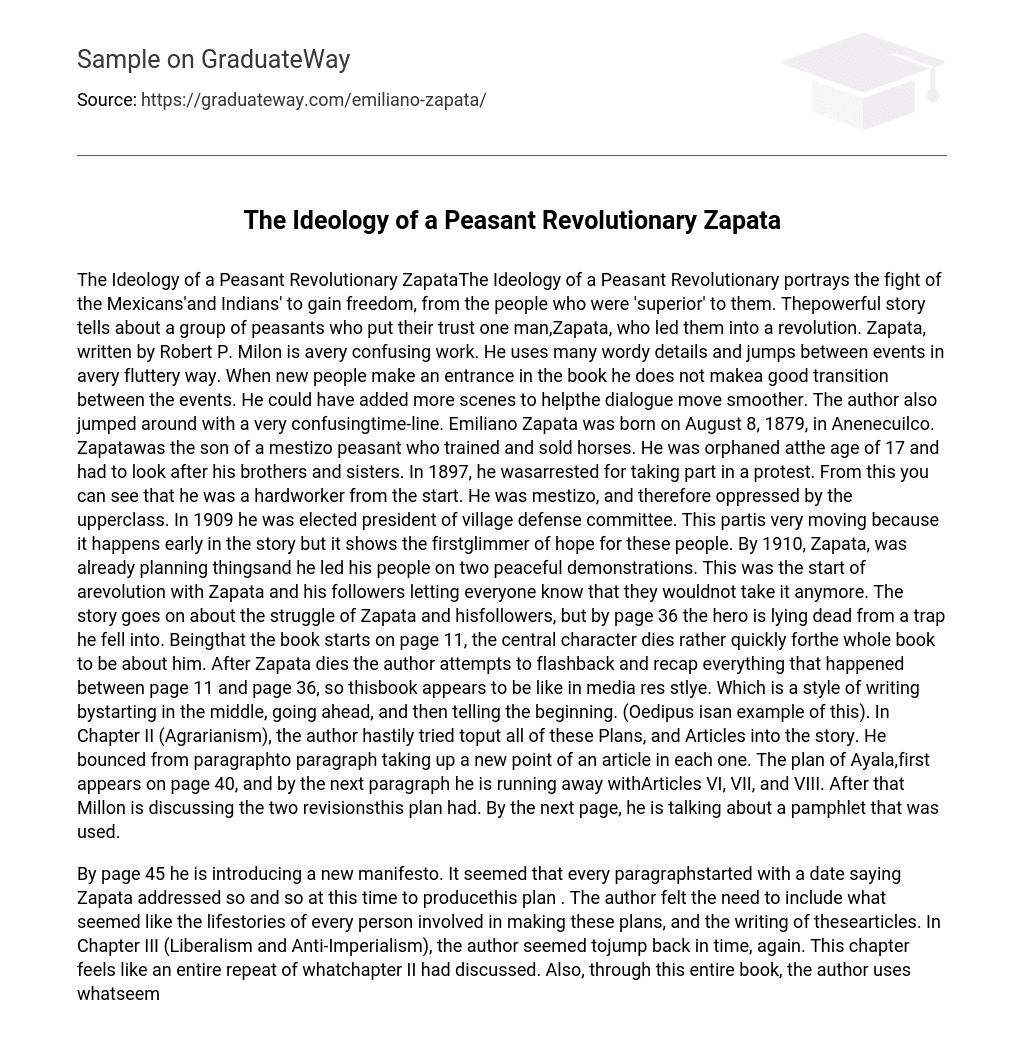The Ideology of a Peasant Revolutionary ZapataThe Ideology of a Peasant Revolutionary portrays the fight of the Mexicans’and Indians’ to gain freedom, from the people who were ‘superior’ to them. Thepowerful story tells about a group of peasants who put their trust one man,Zapata, who led them into a revolution. Zapata, written by Robert P. Milon is avery confusing work. He uses many wordy details and jumps between events in avery fluttery way. When new people make an entrance in the book he does not makea good transition between the events. He could have added more scenes to helpthe dialogue move smoother. The author also jumped around with a very confusingtime-line. Emiliano Zapata was born on August 8, 1879, in Anenecuilco. Zapatawas the son of a mestizo peasant who trained and sold horses. He was orphaned atthe age of 17 and had to look after his brothers and sisters. In 1897, he wasarrested for taking part in a protest. From this you can see that he was a hardworker from the start. He was mestizo, and therefore oppressed by the upperclass. In 1909 he was elected president of village defense committee. This partis very moving because it happens early in the story but it shows the firstglimmer of hope for these people. By 1910, Zapata, was already planning thingsand he led his people on two peaceful demonstrations. This was the start of arevolution with Zapata and his followers letting everyone know that they wouldnot take it anymore. The story goes on about the struggle of Zapata and hisfollowers, but by page 36 the hero is lying dead from a trap he fell into. Beingthat the book starts on page 11, the central character dies rather quickly forthe whole book to be about him. After Zapata dies the author attempts to flashback and recap everything that happened between page 11 and page 36, so thisbook appears to be like in media res stlye. Which is a style of writing bystarting in the middle, going ahead, and then telling the beginning. (Oedipus isan example of this). In Chapter II (Agrarianism), the author hastily tried toput all of these Plans, and Articles into the story. He bounced from paragraphto paragraph taking up a new point of an article in each one. The plan of Ayala,first appears on page 40, and by the next paragraph he is running away withArticles VI, VII, and VIII. After that Millon is discussing the two revisionsthis plan had. By the next page, he is talking about a pamphlet that was used.
By page 45 he is introducing a new manifesto. It seemed that every paragraphstarted with a date saying Zapata addressed so and so at this time to producethis plan . The author felt the need to include what seemed like the lifestories of every person involved in making these plans, and the writing of thesearticles. In Chapter III (Liberalism and Anti-Imperialism), the author seemed tojump back in time, again. This chapter feels like an entire repeat of whatchapter II had discussed. Also, through this entire book, the author uses whatseems to be Mexican or Spanish in italicized words, which makes it very hard toread . Words such as carrancistas, cacique, porfirista, ejidos, &latifundismo appear. As the book went on, more Mexican words showed up. Afterthe foreign words the author should have translated them. Combined with theunorganized writing method employed one needed help getting through the long andtedious chapters. The only thing constant about, Robert Millon’s chaotic writingwas that he started every chapter with a long quote from Zapata himself, to setthe chapter up. Chapter IV, entitled Misconceptions Concerning ZapatistaIdeology, did not help to make anything clearer. The author rambled on making aneffort to explain his past chapters and the concepts surrounding Zapata. Thiswas a failed attempt because the author again goes into wordy descriptions andintroduces an abundance of people and dates. Also, by the end of this chapterthe author feels compelled to use a long list of quotes. Almost every paragraph,is a quote. Millon is not giving the reader his input here, but instead heleaves the reader with pages of quotes to fumble through. It makes it very hardto get through. Chapter IV, named Revolutionary Tactics, Millon discusses thefighting strategy of Zapata and his followers. Again we find ourselves in 1915;the author has backtracked once more. He retells the story of the past fourchapters over again. He goes over the same tiresome details, again. The finalChapter in this sloppily written work, bears the name, The Fate of ZapatistaIdeology, this tiny chapter, is only about four pages . In this last chapter,the author summarizes the previous details to the readers that have already beenintroduced, but now he explains why they did not work that successfully . RobertMillon, is not a skilled writer. He did not do Zapata or his followers justice.
His lack of being able to understand the concept of a time-line, and how tointroduce new people showed throughout this entire work.
BibliographyMilon, Robert. Zapata. International Publishers,1969.





